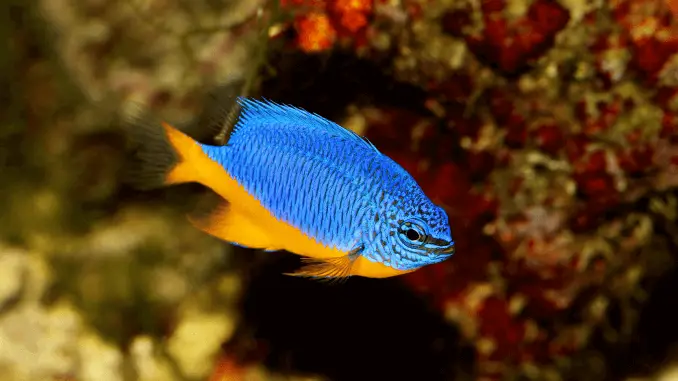
The damselfish belong to the Pomacentridae family, of which there are over 250 species.
Whilst the majority of these damselfish species are found in saltwater, certain species can survive in brackish waters.
The damselfish are renowned for their bright colors, hardiness, and low maintenance.
It’s important to mention that the Damselfish is an extremely large group of fish and as a result, each species of Damsel has its own quirks and individuality.
For this reason, in this guide to Damselfish, we will speak in general of the species whilst giving specific examples for the most common species such as the blue, yellowtail, domino, and azure damselfish.
TABLE OF CONTENTS
Damselfish Facts & Overview
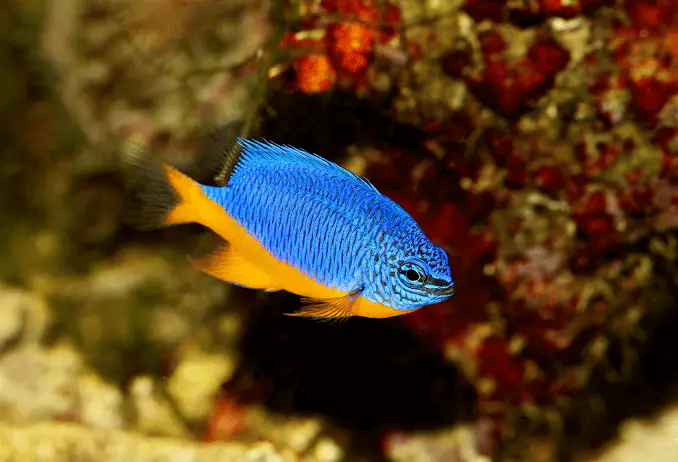
| Category | Rating |
| Care Level: | Easy |
| Temperament: | Aggressive |
| Color Form: | Various |
| Lifespan: | 5-6 years |
| Size: | 3-12 inches |
| Diet: | Carnivore |
| Family: | Pomacentridae |
| Minimum Tank Size: | 30 gallons |
| Tank Set-Up: | Marine: coral or rocks |
| Reef Compatible: | Safe |
Damselfish belong to the Pomacentridae family and there are around 300 species. The majority of these species are saltwater fish found in the Indian and Pacific Oceans.
Their natural environment is in tropical coral reefs and they are lively and active fish.
The majority of Damselfish grow to around 3 inches in length however large species, such as the Garibaldi, can grow up to 12 inches long.
They are well known for their bright colors and aggressive, territorial nature. They can generally be kept in groups of the same species but mixing them with other species can be challenging (read the Compatibility section below).
Most are omnivorous and will feed on both fresh and frozen meat. In addition to their non-fussy eating, they are extremely hardy which makes them ideal for inexperienced keepers. They are so hardy that in fact before fishless cycling came into style, Damsels would be used to cycle a saltwater tank. Fortunately, this practice has mostly stopped now as fishless cycling has become the norm.
It’s important to note here, that the Damselfish family is a large group of fish, and whilst the above generally holds true across the board, each species has its own unique traits and peculiarities.
As mentioned in the introduction, we will cover most of the species here, with an emphasis on the most popular; the Blue Damselfish.
Without a doubt, the Blue Damselfish is one of the bestselling saltwater fish in the US. Due to its durable nature, new fish keepers like its forgiving nature. It isn’t “bulletproof” but can tolerate poor water conditions if you make a cycling mistake.
The Blue Damselfish is territorial and will become aggressive if a fish intrudes on its patch; it will chase and nip at subordinate fish.
Typical Behavior
If you’ve heard anything about the Damselfish before reading this article, chances are someone will have told you they are very aggressive. Some Damsels have even bitten hands that have been placed into aquariums.
You will have also likely heard that they can be a bully in the tank and intimidate more docile species.
Unfortunately, you’ve heard correctly. Even though the majority of Damselfish are small they are very often territorial and are known to claim large areas of the aquarium for themselves. In smaller tanks, they will claim the whole thing.
Anything they deem to be their territory, they will fiercely defend. They will generally chase and nip at any fish that doesn’t fight back. You should keep a close eye on your tank to notice if this is happening. Victims of such behavior tend to become stressed and withdraw; causing them to become sick and stop eating.
When they aren’t defending their territory you will find them feeding!
Small Damsels will feed towards the bottom of the water column whereas larger ones will generally feed higher up the column.
Appearance
There are more than 250 species in the Pomacentridae family. So as you can imagine their appearance can vary a lot from one species to another.
However, as a general overview, Damselfish have deep bodies with forked tails; very similar to cichlids. They have two anal spines and generally have a single nostril on each side of their head.
One of the most well-known features of Damselfish is its vibrant color, ranging from red, yellow to blue.
It’s important to note here though that some Damsels are very colorful as juveniles and lose their color as they age; some can even end up completely brown once they mature. So make sure to research before buying!
Popular Varieties of Damselfish
Blue Damselfish
The most popular variety of Damselfish is the Blue Damselfish (Chrysiptera cyanea).
It will grow up to 3 inches in length and is bright blue in color. Males will have a yellow tail and snout, whereas juveniles and females don’t tend to have the yellow highlights. Interestingly, when threatened, the Blue Damselfish can turn almost completely black in a matter of seconds.
Yellowtail Damselfish
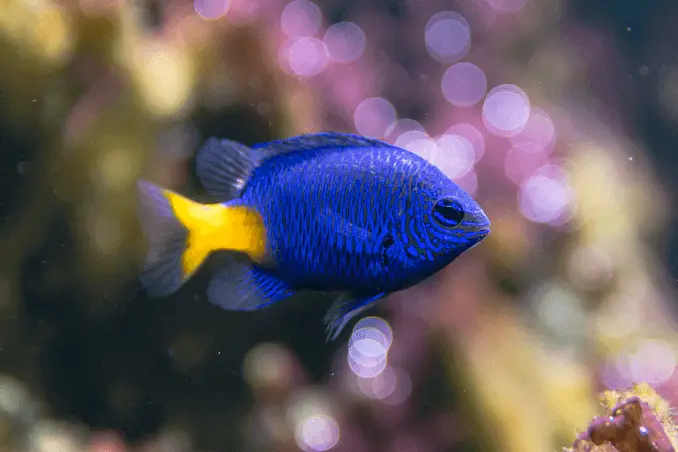 Another very popular variety of Damselfish is the Yellowtail Damselfish (Chrysiptera Parasema).
Another very popular variety of Damselfish is the Yellowtail Damselfish (Chrysiptera Parasema).
Like the Blue Damselfish it sports a blue body however this particular fish has a gorgeous yellow tail fin. It tends to grow up to 3 inches in length and is regarded as one of the best types of Damsel, because it’s one of the least aggressive.
Domino Damsel
The domino Damselfish, also known as the three spots or Dascyllus trimaculatus, is named because of the white spots on its body.
It will grow to 5 inches in size, but beware it is particularly aggressive and should be kept with care.
Azure Damselfish
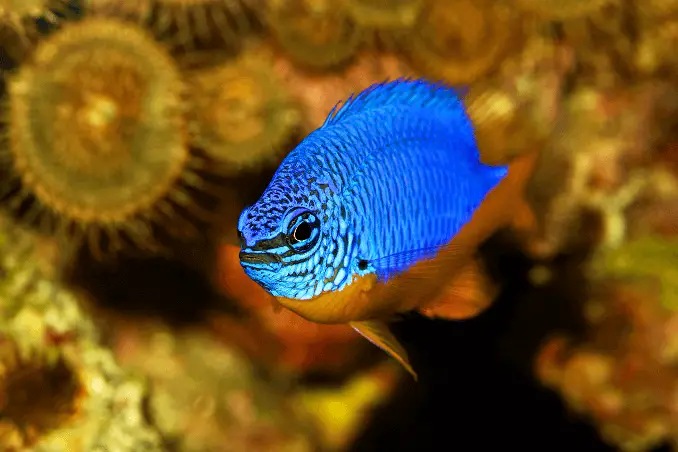 The Azure Damselfish (Chrysiptera hemicyanea) is known as the Half-blue Damselfish. It has a bright blue top and bright yellow bottom-colored body.
The Azure Damselfish (Chrysiptera hemicyanea) is known as the Half-blue Damselfish. It has a bright blue top and bright yellow bottom-colored body.
This type of Damsel is particularly hardy and will grow to 3 inches long.
Bicolor Damselfish
The Bicolor Damselfish are also known as Stegastes partitus is native to the Caribbean.
The front half of the fish is a dark grey/black with the rear half being pale. It can grow up to 4 inches in length and is particularly bony.
Habitat and Tank Requirements
As mentioned in the general overview you will find the majority of Damselfish living in tropical coral reefs, so your aquarium setup should be somewhat similar to this.
The vast majority of Damselfish grow to 2-3 inches in size, so can be kept in small-medium sized aquariums. For instance, the Blue Damselfish can be housed in a 30-gallon aquarium. If you’re planning to keep more than one, then you need to make sure the aquarium is over 50 gallons. And if keeping a school of 4 or more, use at least a 100-gallon tank.
However other types of Damselfish can grow up to 12 inches so would need at least a 100-gallon tank.
Make sure you research your particular species thoroughly. Putting them in small tanks can kill them.
Tank Conditions
Fortunately, Damselfish are incredibly hardy and can adapt to a wide range of conditions.
Following our example of the Blue Damselfish, the water temperature should be between 73°F to 81°F. pH levels should be between 8.1-8.4, with a specific gravity of 1.020-1.025.
Tank-Tip
Without enough space, they can turn aggressive and become increasingly territorial.
As Damselfish like to swim, make sure you have lots of open swimming space and also lots of hiding places. The more Damselfish you keep in a tank the more hiding places you should have. This will help reduce territorial aggression.
Diet
 One of the appealing qualities of Damselfish is that they are very easy to feed and tend to eat just about anything placed into the tank.
One of the appealing qualities of Damselfish is that they are very easy to feed and tend to eat just about anything placed into the tank.
The vast majority of Damselfish are omnivores. They will eat both live and frozen food, in addition to flake food.
We would like to mention though that certain species of Damselfish can be herbivores, so you should research your particular species thoroughly.
The Blue Damselfish is an omnivore, so their diet should be made up of live and frozen meat including brine shrimp, worms, squid, shrimp, copepods, and small pieces of fish.
They will also eat flaked foods and some herbivore preparations.
You will find that the larger the Damselfish, the higher up the water column they will eat.
The current speed also impacts where the Damselfish forages. With slower speeds, they eat higher up the water column, whereas fast speeds will encourage foraging closer to the bottom of the column.
Compatibility with other Fish
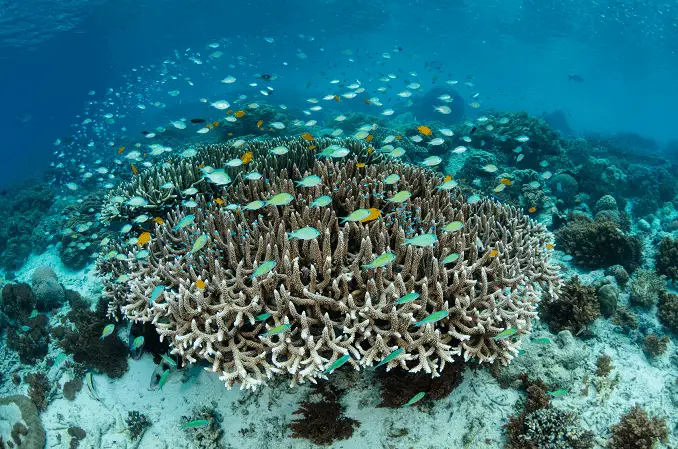 If you’ve read the typical behavior section above, you will know that Damsels are known for being very aggressive towards other fish.
If you’ve read the typical behavior section above, you will know that Damsels are known for being very aggressive towards other fish.
As a general rule, you shouldn’t try to keep different species of Damsels together in the same aquarium. You should keep to one species of Damsel per aquarium. If you’ve got a small aquarium it’s also generally a bad idea to mix other species with Damsels. You should only do this in larger aquariums.
In larger aquariums, you can keep other semi-aggressive fish with most types of Damselfish, such as:
- Clownfish
- Dwarf Angelfish
- Tangs
- Dottybacks
- Bottom Dwelling Gobies
Timid species should be avoided.
If you’re planning to keep Damselfish with other species you need to introduce them to each other correctly. We would recommend adding Damselfish into your aquarium last. This way the other semi-aggressive fish in your tank has already claimed territory and it should prevent the Damsel from taking over the entire aquarium.
Finally, as a general rule most Damselfish will get along fine with invertebrates however they have been known to eat them from time to time. So add at your own risk!
Is the Damselfish Right For Your Aquarium?
Are you looking to add some vibrant color to your aquarium? If yes, the Damselfish could be for you.
Their size, tough nature, and high availability, all make them an extremely popular choice for any aquarist.
Their hardy nature makes them even more popular with beginners as it’s more resilient to common beginner mistakes such as stalled nitrogen cycles.
As previously mentioned, there are over 250 Damselfish species so we couldn’t cover all of them. We hope you found the ones we did cover useful!
Remember to thoroughly research your chosen Damselfish species before you buy it. Each species has its own oddities and individuality.
If you’d like me to cover any species of Damselfish let me know in the comments below. Or if you keep Damselfish already let us know your experience with them in the comments section below…

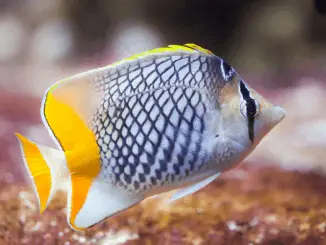
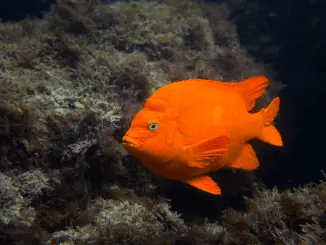

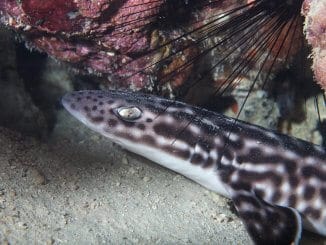

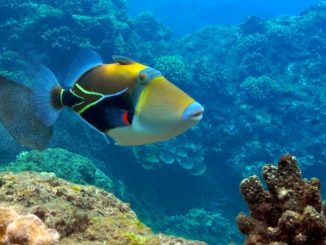
Thank you for an interesting and educational piece.
We have a yellowtail and an azure. This morning I watched them spawn. How long is typical before they hatch? Does the parent guarding eggs, also guard the fry? Thanks for your time.
Sean